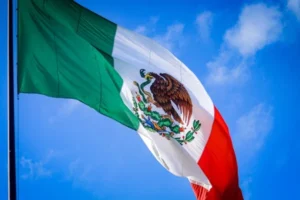History
Teotihuacán was one of the most important cities in Mesoamerica. It was constituted in a political, commercial, social and military emporium where more than 150,000 inhabitants coexist in an area of 20 km. when the city was in all its splendor and exerted full influence on the surrounding territories. There are some hypotheses that speak of the enigma around the abandonment of the city by its inhabitants, among them a voracious fire, whose decline and end is inferred to have been in the seventh century. It is a mystery and it is unknown what its original name was, where its first inhabitants came from and the exact theory of the causes that led to its abandonment.
There are assumptions that a part of the Teotihuacans came from the Anahuac Valley and another from Cuicuilco. It was only with the discovery made by the Aztecs in the fourteenth century of the ruins, when they arrived from the north and baptized it as Teotihuacán which means “place where the gods were created”, giving their sacred worldview to the site and baptizing its main monuments as Pyramid of the Sun and Pyramid of the Moon.
Teotihuacan as a bastion of archaeological studies
The city of Teotihuacán has become an important bastion in the field of archaeological research since it is one of the most explored sites in the area of Mesoamerica. Its discovery and the different excavations that allowed to unveil all the cultural and archaeological treasure that it contains, date from the eighteenth century. Temples, wall paintings, buildings, squares, monuments and pyramids opened a world of possibilities for the development of archaeological and anthropological studies in the country.
In recent years, the different institutions of the Mexican state that lead the research have been strengthened, using an interdisciplinary team that continues to position the urban past of this archaeological complex and that envisions local development. However, despite the fact that the city has been the subject of scientific research for more than a century, only 5% of its spaces have been explored and excavated.
And the Sun and the Moon were made
Legend has it that once the gods met, over there, by Teotihuacán, in the times where the night predominated. They were planning the light of the new day so they asked who would carry the light on their backs. Tecuciztécatl, who was among those present, proposed but someone else was missing. Everyone fearful did not want to go for what they chose Nanahuatzin and accepted because of the deep love he professed to the gods. Tecuciztécatl and Nanahuatzin fasted as an act of penance while preparing their offerings while the gods prepared the fire of the divine rock.
Tecuciztécatl’s offerings were the most striking and precious. Feathers of quetzal, gold, copal, coral blood and jade thorns. Nanahuatzin on the other hand offered medicinal plants, ocote, green reeds, maguey thorns. Each of them went up to do penance in the mountains built and given by the gods, what today are the pyramids of the sun and the moon. After his penances, each one came down and was given touches for his clothing. To Tecuciztécatl, heron feathers and to Nanahuatzin, one of paper. The gods gathered around the fire and placed the two in the center.
Tecuciztécatl was ordered to enter the fire so he anxiously went ahead but retreated with fear because of the burning of the fire. He tried to return again and again and was unable to comply with the order. Nanahuatzin was ordered to throw himself into the flames at that moment, determined, he closed his eyes, filling with courage his heart threw himself into the flames to burn in the divine fire. Tecuciztécatl, inspired by Nanahuatzin’s decision, overcame his fear and threw himself into the fire, but it turned out late. An eagle descended into the fire when suddenly an ocelot fell inside almost extinguishing the flames. This event explains the dark plumage of the eagle and the spots of the ocelot.
Done this the gods waited for the appearance of Nanahuatzin in the firmament like a sun. And it appeared in the east with an incandescent red hurting the eyes of those who see it directly but providing warmth. Tecuciztécatl appeared moments later shining with equal intensity and had a dilemma of what to do with two suns so they grabbed a rabbit and slapped the second one obscuring its brightness. This is how the legend tells the birth of the sun and the moon, as well as the divine origin of the pyramids as a tribute to these stars.
The Pyramid of the Sun
There are 264 hectares in total of the area that corresponds to the public visit which can be accessed through five doors and that leads to the area of the monuments, including the Pyramids. To start this tour you enter through door 1 and end through door 3. It addresses a main cobbled road known as the road of the dead that flanks the entire route to reach the Pyramid of the Sun which is located on the eastern side of the road. It stands majestically challenging for being the largest monument in the entire complex and the second in Mesoamerica. Its construction dates from the tzacualli cultural period of I-150 AD. and has a height of 63 meters with a length of 225 meters, crowned at its top or cusp by a ceremonial temple.
Adobe was used for its construction, it was covered with stucco as well as being ornamented by religious paintings of bright colors. The Pyramid of the Sun and its five levels were built on a tunnel or “sacred cave”, discovered in 1971 by Jorge Ruffier Acosta, which according to conjectures may be a natural cave used for rituals or sacred ceremonies and that justify the construction of the pyramid on it. Through explorations of the tunnel it was found that its end is located in the center of the pyramid where there is a chamber that could be mortuary according to hypotheses.
The position of alignment of the Pyramid of the Sun with Cerro El Gordo denotes that it was highly studied by the astronomical criteria that deprived in the planning of the city. Its current appearance corresponds to the restoration work carried out by Leopoldo Batres between 1905 and 1910 around the commemoration of the Centennial of the Independence of Mexico.
The Pyramid of the Moon
It is located on the north side of the road of the dead and is the oldest building in the complex. It turned out to be smaller than its companion, the Pyramid of the Sun. At the top, in the quadrant of the cusp, rituals were performed in honor of the goddess Chalchiuhtlicue, goddess of the water regentora of the moon. It had no interior chambers and offerings were placed at its base. Its square plan measures approximately 45 meters per side. Its height is 45 meters, smaller than the Pyramid of the Sun but built on a higher ground so that at first glance they are equal in height. It could also have functioned as an observatory where the Teotihuacans observed the movement of the stars.
The Pyramid of the Feathered Serpent
This pyramid is located in the set of La Ciudadela, in the western part of the Causeway of the Dead. It is the third building in importance after the Pyramid of the Sun and the Moon. It has a civic-religious character which is constituted in the heart of the city. It is located at some distance from the two previous pyramids and was discovered in 1920. Erected on a quadrangular square of 400 meters per side, its construction style responds to the slope-board system with seven bodies and each board is ornamented with the heads of Quetzalcoatl or the Feathered Serpent, an important god within Mesoamerican mythology responsible for the fecundity of the earth and life, represented by a rattlesnake with plumage of the Quetzal bird.
Alternating with it are also sculptures of the god of rain and fertility, Tlaloc, but also of the overwhelming and destructive forces of water and storms. These two deities were the most important within the Cosmogony of Teotihuacan. These sculptures in their flourishing era were decorated with a beautiful polychromy. The pyramid also has a tunnel with three chambers that could function as tombs of important personalities. Behind it are housing complexes where the elite lived.
Contributions to Architecture
It is important to highlight the relevance in the contributions to architecture with the urban layout of the city in the form of roads and around them a main road that led to the monuments and flanked the entire city. All this served a particular worldview of the city and the resources it offered to its inhabitants. This form of urban planning responds to two criteria, one religious that has to do with the astronomical and another with the topographical. The central part of the city is adjusted around the position of the Pyramid of the Sun and the southern part is organized around the Citadel.
Both structures marked the east and west in order to structure a calendar that allowed observing and planning ceremonies and agricultural work. The planning of the city in the form of a checkerboard whose confluence was around the main buildings denoted a centralized power. It is also noteworthy the efficiency in the water supply system for the city and drainage.
It is also important to highlight the contribution and development of the slope-board construction style used in the realization of the pyramids. It consisted of the alternating placement of a board or platform on the top of a wall shaped like an inclined slope. This form of construction radiated and influenced the other regions of Mexico.
Broadly speaking, we have delved into the characteristics that make the pyramids of Teotihuacán one of the wonders built by civilizations that left a deep mark on history. It is up to institutions and researchers to continue delving into the enigmas of the origin of the majestic and monumental city of Teotihuacán.











One Response
Ive been meaning to publish about something like this on my website and this gave me an idea. Exactly the stuff I needed.